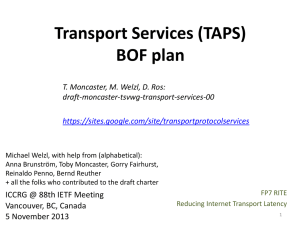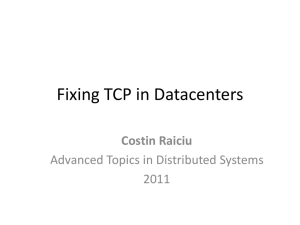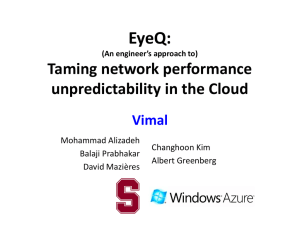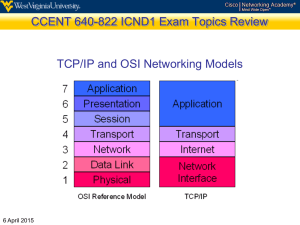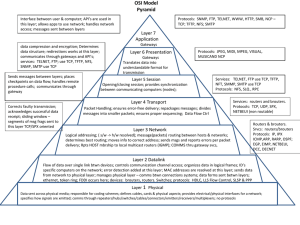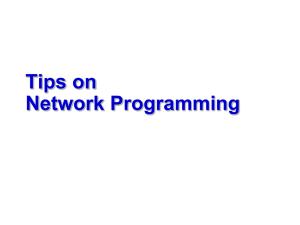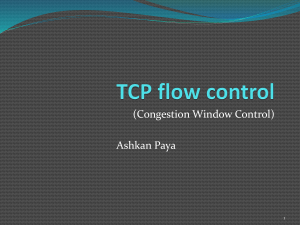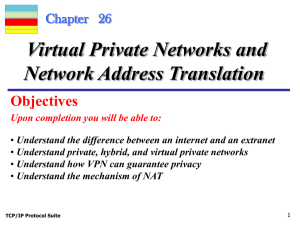Transport Services
advertisement
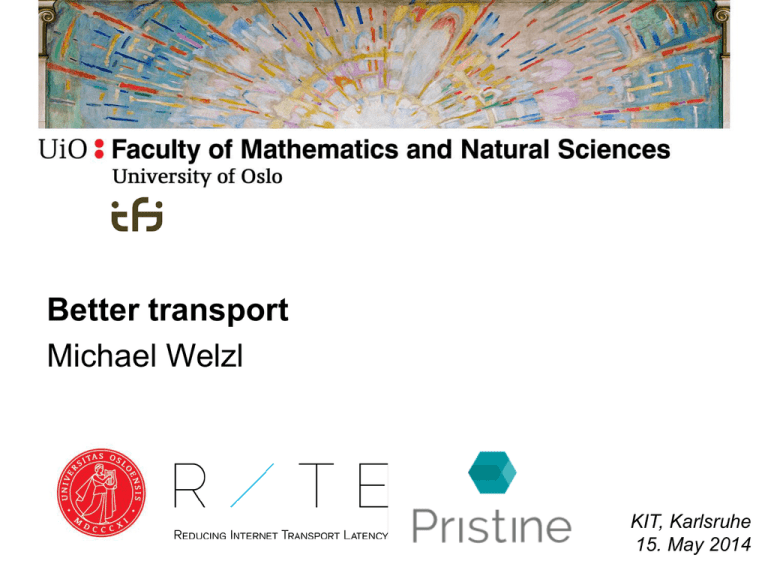
Better transport Michael Welzl KIT, Karlsruhe 15. May 2014 Context • 15 years of almost only transport layer research – Because it’s so bad and I’d like to fix it 1. Gradual, deployable (reasonable) – Strong focus on IETF (TCP, AQM, WebRTC, TAPS) – RITE EC FP7 project 1. More, um, “forward looking” (crazy?) – RINA architecture – PRISTINE EC FP7 project 2 Part 1: The Internet's transport API, done the right way TRANSPORT SERVICES (TAPS) 3 Problem addressed • Internet transport layer = TCP, UDP – Service = what these protocols provide – Does not match the diversity of today’s applications Layer N+1 protocol N2 N1 node A entitiy N1 node B service interface N2 Layer N: services N1, N2 vertical comm. horizontal comm. • OSI had the right idea! :-) abstraction. – Layers merely provide a service – Lower layers + their internal operation hidden could be replaced • Transport layer should be especially easy to change! 4 Why is this so bad? • Without abstraction, innovation is very limited • We’re stuck with the Internet services (protocols) of the 80’s! 5 The 80s 1) Reliable byte stream, TCP 2) Datagram, UDP 6 Why is this hard to fix? • Checking for availability on the other side, compatibility with the network path, fall-back to TCP/UDP: all left up to the application programmer – Significant effort, for often no gain – Pain vs. gain just isn’t right • QoS has a very similar problem – RFC 2990 describes chicken-egg situation 7 The 90s IntServ over DiffServ! From http://blog.sendmemobile.com/music-humor/ten-1990s-artists-who-need-a-comeback 8 QoS, really? • Internet (IP over everything) + strict QoS guarantees was never a good fit – Alternatives have always been proposed – e.g. Alternative Best Effort (ABE) Service (Paul Hurley, Jean-Yves Le Boudec, Patrick Thiran) – Could do that, or try QoS and fall back – Former: currently being proposed in IETF as draft-lai-tsvwg-normalizer (part of the AEON effort) – Latter: indirectly being proposed via draft-ietf-rtcweb-qos (related to new DART WG) 9 One hammer for two nails 1. Introduce abstraction: Applications specify a transport service (what they need) instead of “TCP” or “UDP” (how it is implemented) – Else: • How do you provide a low-latency-but-less-bandwidth service to a flow when you don’t know that it wants it? • How do you make a flow benefit from faster delivery of outof-order packets when all flows expect TCP-like service? 2. A system underneath this API could automatically make the best of what is currently available, with a fall-back, typically to TCP (best effort) 10 Transport Service examples • Faster out-of-order delivery (e.g. SCTP) – Fallback: slow in-order delivery (TCP) • Partially unreliable delivery (e.g. SCTP) – Fallback: reliable, but throw away if it arrives too late (TCP) • More capacity via multiple paths (e.g. MPTCP) – Fallback: less capacity via one path (TCP) • Lower latency at the potential cost of throughput (e.g. more FEC in some NC-TCP-variant, or some queuing behavior via a DSCP) – Fallback: a lot of latency via TCP • …Yes, TCP fits for a lot of things 11 Zig-zagging for community support TAPS IN THE IETF 12 Bottom-up as a compromise (top-down never had an effect) Example to the right shows: possible to systematically arrive at a result (table shows services provided by TCP, SCTP, DCCP, UDP-Lite (RFCs, Dec. 2010) x = always on empty = never on P1 = partial error detection t = total reliability p2 = partial reliability o = ordered u = unordered [M. Welzl, S. Jörer, S. Gjessing, "Towards a Protocol-Independent Internet Transport API”, FutureNet workshop, ICC 2011] 13 13 Resulting API in that paper • • Goal: make usage attractive = easy; stick with what programmers know: minimize deviations from socket interface Most services chosen upon socket creation – int socket(int domain, int service) • • – service number identifies line number in table; understandable aliases: e.g. TCPLIKE_NODELAY, TCPLIKE, NO_CC_UNRELIABLE for lines 1-3 Sending / receiving: provide sendmsg, recvmsg We classified features as: – static: only chosen upon socket creation • flow characteristic – configurable: chosen upon socket creation, adjusted later with setsockopt • error detection, reliability, multi-homing – dynamic: no need to specify in advance • application PDU bundling (Nagle in TCP) • delivery order: socket option or flags field 14 IETF-87 in Berlin, July 2013 • Presentation of Minion in TSVAREA • ISOC panel discussion – Stuart Cheshire, Apple: “when we look at the last 30 years of computing, it's amazing how things have changed. But if you wrote an application 30 years ago, your choice was: TCP and UDP. If you write an application now, your choice is: TCP and UDP.” • Some relatively recent related IETF work: – LEDBAT, RTMFP, MPTCP (RFC6897, appendix A: Requirements on a Future Advanced MPTCP API) • People started talking about QUIC • I (with Jon Crowcroft, Toby Moncaster) decided: Let’s do a BOF in London, March 2014! 15 August-October 2013 • Started mailing list and website – Copied Harald Alvestrand’s RMCAT approach – Still there, and still the one central “meeting point”: https://sites.google.com/site/transportprotocolservices/ • Started work on charter – Plan based on me thinking of my bottom-up work – Avoided: goal = API, rather: specify services, describe an example API – Major concern: how to decide which services are in/out? Where to draw the line? Turned out to be no problem 16 IETF-88 in Vancouver, November 2013 • Bar BOF very well attended and lively – Major concern raised: bottom-up not applicationoriented enough; should specify more abstract services Must be relevant to what app programmers really want • Other signs of growing interest; e.g. TSVAREA session: “We would like to give time to the Transport Area to discuss any potential need to evolve the IETF transport protocols.” – QUIC was presented in this session – People started mentioning “Transport Services” 17 December 2013 - February 2014 • Incorporated feedback in the charter (now: describe bottom-up; describe top-down; define mapping) – And specify an example implementation – Common view: no protocol defined not IETF • Several Internet-drafts: problem statement, use cases, … most importantly, survey of common APIs and how they could be supported with transport services – Involved Martin Sustrik, creator of ZeroMQ • Requested BOF; was made “non-WG forming” – Decision by Tranport Area Directors, to help 18 IETF-89 in London, March 2014 • Non-WG forming: no wordsmithing no charter discussion Agenda: Introduce problem (Jon Crowcroft) Explain how it could support middlewares (Martin) Explain how it fits with ongoing IETF work (MIF) (Margaret) Describe what an implementation could look like (Gorry) • 129 participants, more than 6650 words spoken in debate – Major concern: provide what application programmers want (again…) 19 And now? • Something is happening – Interest is clear – I was asked to write an article about TAPS for the IETF journal – There might be a (WG-forming) BOF at the next IETF, but I probably won’t chair it – People in charge consider broader picture: other BOF proposals (e.g. AEON is highly complementary), there might be related things happening in IAB… • If we get a WG, so what? – Indeed… this is an old story, and lots of standards are unused – Will need a lot of energy to really achieve something – To quote Jon Crowcroft: “success seems to depend on code quality” 20 Congestion control, done the right way CONGESTION CONTROL IN RINA 21 What’s so wrong about Internet congestion control? 7-619305 PRISTINE • Its end-to-end’ness Collaborative Pr – Justification with e2e-argument is wrong; e2e-argument is about functionality 8.2. Workapplication-specific Package 3 (also doesn’t forbid complex routing) • IP over everything, but TCP CC. too… • No wonder we have research on TCP-over-link-layer-X! – But is this really useful research, or a waste of time caused by wrong design? 22 Congestion control, better • Link layers have their own overload control; could we just connect them somehow and provide backpressure? – Idea influenced by: • Crowcroft, J., Hand, S., Mortier, R., Roscoe, T., and Warfield, A. 2003. Plutarch: an argument for network pluralism. SIGCOMM Comput. Commun. Rev. 33, 4 (Oct. 2003), 258-266. • Schläger, M. 2004. The remote socket architecture: A proxy based solution for TCP over wireless. Ph.D. thesis, TU Berlin, supervised by Kurt Geihs, Adam Wolisz and Lars Wolf. • John Day’s book “Patterns in Network Architecture”, describes Recursive InterNetwork Architecture (RINA) – Fits this vision well but no congestion control defined – This will be investigated in the PRISTINE project 23 RINA • Recursive, meaning: all layers (Distributed InterProcess Facilities, DIFs) have the same basic functions – Layers provide scope 24 RINA: example, just one step away from IP… Scope 2 Alice … NAT1 Scope 1 • • • • … NAT2 … Bob Scope 3 Alice can’t immediately reach Bob Alice tells NAT1: I’d like to talk to Bob Enrollment NAT1 can find & ask NAT2… Addressing in scope 1 and scope 3 can be 25 completely different RINA: much about addressing / naming • Doing this right facilitates mobility, multihoming • More secure: enrollment authenticated, else can’t even reach a node • Management should be easier 26 communicate, generalizing the model of local inter-process communications. A DIF is an organizing structure, grouping together application processes that provide IPC services and are configured under the same policies. A DIF can be seen as what we generally refer to as a ``layer''. According to this view, networking is not a layered set of different functions but rather a single layer of distributed IPC that repeats over different scopes, i.e. providing the same functions/mechanisms but tuned under different policies to operate over different ranges of the performance space (e.g. capacity, delay, loss). Figure 3 provides more details of the RINA architecture. Not only the structural blocks (the DIFs) and interfaces between them are identified, but also the components within them. The instantiation of a DIF within a system (a computer) is an IPC Process, an application that provides distributed IPC Services. Each IPC Process can have the following components (``can'', because not all IPC Processes will require to have all of them): Of course, many usual functions needed… • But: clean separation between “policy” and “mechanism” 27 RINA: DIF implementations differ (policies) 28 FP7-619305 PRISTINE B8.2. Congestion Work Package 3 Collaborative Project control in PRISTINE 29 Envisioned operation • Permanently active control loops (aggregates) between all edges • Each aggregate has a weight (number of flows) • Each edge must know mapping between adjacent aggregates and internal aggregates 30 Aggregate-based congestion control • Large number of potential benefits – – – – Control where the problem is Can use explicit signaling based CC in a DIF Theoretically, infrastructure-specific CC possible Aggregating flows together yields less competition for resource (less queuing => less delay/jitter) – Bandwidth given up by application-limited flows can be given to greedy flows – Priority support, even QoS should be possible – Enable load-based routing! • But: how well can this scale? – E.g., if DIF changes at every hop, this becomes hop-by-hop CC. 31 Thank you! Questions? 32 Backup slides 33 Example benefits [M. Welzl, F. Niederbacher, S. Gjessing, "Beneficial Transparent Deployment of SCTP: the Missing Pieces", GlobeCom 2011] Transparent usage of SCTP’s multi-streaming underneath TCP SCTP association with multi-streaming • map each connection on different stream • message based data transmission • shared flow control • shared congestion control TCP connection Host B benefits • subsequent data transfers have new cwnd - value • faster startup if association already exists • multihoming only active if demanded or beneficial Gateway TCP connection Connection manager gateway • connect to GW • bytestream transfer • flow control • congestion control Gateway • connection attempt management • setup SCTP association • read/write from TCP connection • read/write on SCTP association • open/close new TCP connection • gateway signaling protocol original TCP connection (possible to bypass the gateway) Host A 34 Test result 1. Shows what can be achieved by using SCTP underneath the app without even changing the transport API 35 2. Shows that you don’t have to put it in the OS (user space, middle-box, …) 35


